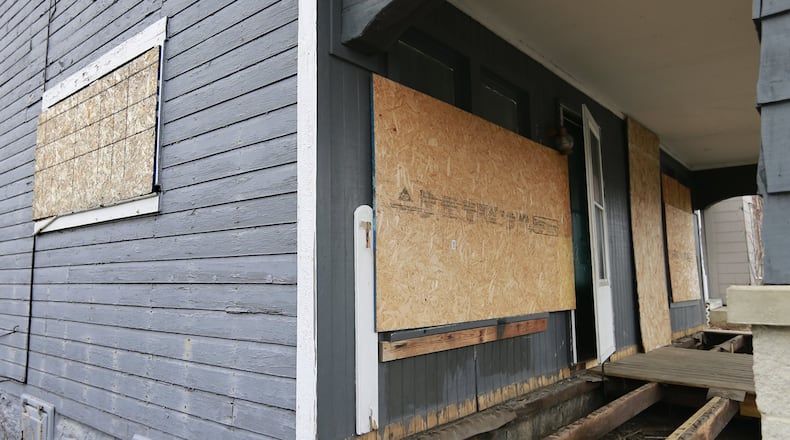RELATED: Record number buyers investing in foreclosed Clark County homes
But moving forward, lenders will be required to use alternative boarding materials, such as a glass-like polycarbonate that is easier on the eye and doesn’t advertise that a home or building is vacant, supporters said.
Gov. John Kasich signed this month House Bill 463, which prohibits mortgage lenders from using plywood to secure vacated and abandoned properties they are foreclosing on.
Critics say plywood is ugly, easy to damage and remove and itself become an emblem of decay and disinvestment, which is often no better than the broken-out doors and windows they cover.
The law won’t affect Springfield or other municipalities that board up abandoned structures, Springfield Planning, Zoning and Code Administrator Stephen Thompson said. He believes the new requirements might improve blight in neighborhoods.
READ MORE: $630K grant will demolish up to 65 homes in Springfield
“I would hope so but it’s hard to tell what the real impact of something like this will be,” Thompson said.
Springfield has hundreds of boarded up houses across the city, Thompson said. However it’s hard to tell exactly how many because the city, the Clark County Land Bank and a number of mortgage lenders all secure structures, as well as what state they’re actually in, Thompson said.
The law, the first of its kind across the country, means mortgage service firms and others will have to stop using a product that contributes to deterioration of neighborhoods in favor of alternatives such as “clear boarding technology,” said Robert Klein, founder and chairman of Community Blight Solutions in Cleveland.
Klein’s company manufactures SecureView clear board products, which are a transparent material that’s a substitute to plywood.
Springfield uses a different type of engineered wood material — oriented strand board — to secure abandoned houses, which are then painted white with no trespassing markings, Thompson said. Last year, Springfield spent about $22,800 to board up 94 structures in the city.
If the law were to impact Springfield, it could raise its costs by nearly 10 times its current rate, Thompson said. Strand board costs about $10 for a 4-by-8 sheet, while clear board products costs about $90 for a similar piece.
“Our costs would go to about $200,000 to do the same type of work,” Thompson said.
Clear boarding products are shatter- and tamper-proof, preventing vandalism, trespassing, squatting and other crimes in vacant properties, said Klein, who advocated for House Bill 463.
Clear boards allow police and property owners to see inside buildings to make sure no intruders or other trouble is inside.
Most notably, clear boards tend to be indistinguishable from windows and glass doors, meaning they don’t publicize that a property is empty as plywood does, Klein said.
“You can’t tell a property is vacant,” he said.
Clear boarding products are more expensive than plywood. A 48-by-96-inch SecureView window cover runs about $115 per sheet. A SecureView security door costs about $395.
But plywood has a limited lifespan and may have to be replaced multiple times if a property sits vacant for an extended period of time, officials said.
Mortgage lenders will be most impacted by the legislation, but they often maintain their properties using conventional locking products instead of boarding.
Fannie Mae, one of two massive U.S. government-backed agencies to buy and guarantee mortgages, was an early adopter of clear board alternatives.
The housing finance giant started using polycarbonate coverings in 2013 to maintain its post-foreclosure properties in a handful of states, including Ohio.
By the end of 2014, Fannie Mae had implemented clear boarding across all of its markets.
Vendors and mortgage service firms hired by Fannie Mae have retrofitted 4,000 properties across the country using clear boards, and they also have placed polycarbonate covering on about 11,000 vacant properties in the last year and a half, said Jake Williamson, vice president of Fannie Mae’s distressed assessment fulfillment division.
Fannie Mae hires vendors and mortgage servicers to handle administrative work for the mortgages and managing vacant properties.
Fannie Mae also now allows and wants its vendors and mortgage servicers to use clear boards to secure vacant properties that are in pre-foreclosure status, Williamson said. The agency may retrofit more of its properties with clear boards.
“We feel the product is a bit safer and more secure than plywood,” he said.
By the numbers
94: Houses boarded up by the city of Springfield in 2016.
$22,800: Money Springfield spent to board up houses last year.
4,000: Properties Fannie Mae has retrofitted nationwide with clear boarding materials


